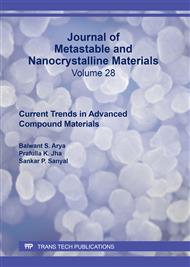[1]
R. Stewart McWilliams, Dylan K. Spaulding, Jon H. Eggert, Peter M. Celliers, Damien G. Hicks, Raymond F. Smith, Gilbert W. Collins and Raymond Jeanloz, Science 338 (2012) 1330.
DOI: 10.1126/science.1229450
Google Scholar
[2]
C. H. Bates, W. B. White and R. Roy, Science 137 (1962) 993.
Google Scholar
[3]
A. Mujica, Angel Rubio, A. Munoz and R.J. Needs, Rev. Mod. Phys. 75 (2003) 863.
Google Scholar
[4]
Haozhe Liu, Ho-kwang Mao, Maddury Somayazulu, Yang Ding, Yue Meng, and Daniel Häusermann, Phys. Rev. B 70 (2004) 094114.
Google Scholar
[5]
Roberto J. Guerrero-Moreno and Noboru Takeuchi, Phys. Rev. B 66 (2002) 205205.
Google Scholar
[6]
K. B. Joshi, U. Paliwal, K.L. Galav, D.K. Trivedi, and T. Bredow, J. Solid State Chem. 204 (2013) 367.
Google Scholar
[7]
A. Aïdouni, A. Zaoui and M. Ferhat, Phys. Stat. Solidi (b) 251 (2014) 1426.
Google Scholar
[8]
Feng Peng, Qiang Liu, Hongzhi Fu and Xiangdong Yang, Solid Stat. Commun. 148 (2008) 6.
Google Scholar
[9]
A. Schleife, F. Fuchs, J. Furthmüller, and F. Bechstedt, Phys. Rev. B 73 (2006) 245212.
Google Scholar
[10]
Wenxia Feng, Shouxin Cui, Haiquan Hu, Guiqing Zhang, Zengtao Lv and Zizheng Gong, Phys. Stat. Solidi (b) 247 (2010) 2202.
Google Scholar
[11]
Gen-Quan Li, Cheng Lu, Xing-Qiang Yang, Shao-Wu Xiao, Ai-Hua Wang, Li Wang and Xiao-Ming Tan, High Pres. Res. 30 (2010) 679.
Google Scholar
[12]
K. J. Chang and M. L. Cohen, Phys. Rev. B 30 (1984) 4774.
Google Scholar
[13]
M. Causa, R. Dovesi, C. Pisani and C. Roetti, Phy. Rev. B 33 (1986) 1308.
Google Scholar
[14]
J. E. Jaffe, J. A. Snyder, Z. Lin and A. C. Hess, Phys. Rev. B 62 (2000) 1660.
Google Scholar
[15]
A. N. Baranov, V. S. Stepanyuk, W. Hergert, A. A. Katsnelson, A. Settels, R. Zeller and P. H. Dederichs, Phys. Rev. B 66 (2002) 155117.
DOI: 10.1103/physrevb.66.155117
Google Scholar
[16]
D. Alfe, M. Alfredsson, J. Brodholt, M. J. Gillan, M. D. Towler and R. J. Needs, Phys. Rev. B 72 (2005) 014114.
Google Scholar
[17]
A. Schleife, F. Fuchs, J. Furthmuller and F. Bechstedt, Phys. Rev. B 73 (2006) 245212.
Google Scholar
[18]
Y. Z. Zhu, G. D. Chen, H. Ye, A. Walsh, C. Y. Moon and S. H. Wei, Phys. Rev. B 77 (2008) 245209.
Google Scholar
[19]
A. Gueddim, N. Bouarissa and A. Villesuzanne, Phys. Scr. 80 (2009) 055702.
DOI: 10.1088/0031-8949/80/05/055702
Google Scholar
[20]
Z. J. Liu, Y. X. Du, X. L. Zhang, J. H. Qi, L. N. Tian and Y. Guo, Phys. Status Solidi (b) 247 (2010) 157.
Google Scholar
[21]
O. L. Andreson and P. J. Andreatch, J. Am. Ceram. Soc. 49 (1966) 404.
Google Scholar
[22]
Y. Fei, Am. Miner. 84 (1999) 272.
Google Scholar
[23]
F. Bertram, S. Giemsch, D. Forster, J. Christen, R. Kling, C. Kirchner and A. Waag, Appl. Phys. Lett. 88 (2006) 61915.
DOI: 10.1063/1.2172146
Google Scholar
[24]
J. W. Chiou, et al., Appl. Phys. Lett. 89 (2006) 43121.
Google Scholar
[25]
D. W. Hafemeister and W. H. Flygare, J. Chem. Phys. 43 (1965) 795.
Google Scholar
[26]
Dinesh Varshney, N. Kaurav, P. Sharma, S. Shah and R. K. Singh, Phase Trans. 77 (2004) 1075.
Google Scholar
[27]
PK Jha and SP Sanyal, Physical Review B 52 (1995), 15898.
Google Scholar
[28]
PK Jha and P Sanyal, Indian Journal of Pure and Applied Physics 31 (1993), 469-473.
Google Scholar
[29]
PK Jha, SP Sanyal, Physica B: Condensed Matter 216 (1995), 125-131.
Google Scholar
[30]
PK Jha, SP Sanyal, Physica C: Superconductivity 271 (1996) 6-10.
Google Scholar
[31]
J. C. Slater and J. G. Kirkwood, Phys. Rev. 37 (1931) 682.
Google Scholar
[32]
R. J. Euiot, R. A. Leath, in: G.K. Horton and A.A. Maraduddin (Eds. ), Dynamical Properties of Solids, Academic Press, New York, Vol. II 386 (1976).
Google Scholar
[33]
L. Vegard, Z. Phys B 5 (1921) 17.
Google Scholar
[34]
F. D. Murnaghan, Proc. Natl. Acad. Sci. U. S. A. 3 (1994) 244.
Google Scholar


